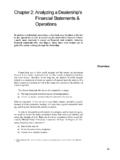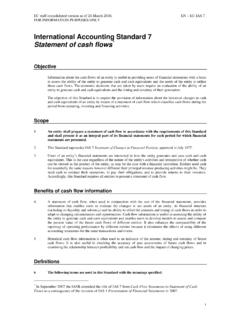Transcription of Joint Venture in Construction Industry - IOSR …
1 IOSR Journal of Mechanical & Civil Engineering (IOSR-JMCE) ISSN: 2278-1684PP: 60-65 Second International Conference on Emerging Trends in Engineering (SICETE) 60 | Page College of Engineering, Jaysingpur Joint Venture in Construction Industry , , Ms Patil, , Ms Hiravennavar, , Prof. Department Of Civil Engineering, ATS, SBGI, College of Engineering, Miraj. Abstract - The Joint Venture company (JVC) is the most common form of organizational structure where the parties wish to establish and operate a jointly owned business. The JVC, unlike a partnership, will have a distinct legal entity and also have the certain time limit.
2 Joint Venture provides strength in term of achieving goals to Construction companies. It will offer a unique opportunity to combine the distinctive competencies and the complemenry skills of participating firms. The option such as risk reduction, sources of finance, access to market can make Joint Venture more attractive option. However problems could occur due to lack of trust between the partners and lack of strong and effective leadership. Paying great attention to the management of human resources and facilitating team building exercises was considered critical for success. 1. INTRODUCTION A Joint Venture (JV) means; An enterprise, co-operation or partnership, formed by two or more companies, individuals, or organizations, at least one of whom is an operating entity that wishes to broaden its activities for the purpose of conducting a new, profit motivated business of permanent duration.
3 In general the ownership is shared by the participants with more or less equal equity distribution and without absolute dominance by one party. An "operating Joint Venture " is a partnership through which two or more firms create a separate entity to carry out a productive economic activity in which each partner take part in decision making. Each party to the operating Joint Venture makes a substantial contribution in the form of capital and technology to marketing experience, personnel and physical assets. An operating Joint Venture is also different from interfirm arrangement which does not creat a separate entity.
4 2. TYPES OF Joint Venture Integrated Joint Venture : Primary characteristic is that it can represent a true partnership, in that the parties share profit and losses. The interest may be 50:50% or some other division and there may be two or more members. The members share the profit and losses in proportion to their interest in Joint Venture . The parties combine resources and personnel in an agreed upon manner. This type of Joint Venture is used in projects which are of immense size and task of splitting the work is very difficult. As a result planning and programming can become complicated and required highly structured and authoritative central management.
5 Typically used: Strong, lengthy relationship between parties. Non-linear, complex projects. Non-integrated Joint Venture : Primary characteristic is that it is not a partnership in that there is no sharing of profit and losses. Each member is taken for specific scope of work and is responsible for the profit or losses associated with that scope of work. Each member is solely responsible for the resources necessary to perform its specified scope of work. The advantage of this type of Joint Venture is that for the contractor entering in to the Joint Venture , each can complement the others skills. But the disadvantage is that some contractors have put more efforts than others, thus leading to internal conflicts.
6 This type of Joint Venture is used in projects where total work can be divided in to different sections. These sections can be subcontracted out to separate partners, who are responsible for technical and administrative element of those sections. Typically used: Limited relationship between parties is desired. Linear projects with distinct work scopes. Combination Joint Venture : They present a combination of an integrated and non-integrated Joint Venture . Each member takes on specified scope of work and responsible for the profit or losses associated with that scope of work19. But the Joint Venture in Construction Industry Second International Conference on Emerging Trends in Engineering (SICETE) 61 | Page College of Engineering, Jaysingpur member also agree to act as partners with respect to a portion of the necessary work, which may include sharing the preliminaries and general condition necessary for each member s separate scope of work, as well as the actual performance of portion of the work of the project.
7 This type of Joint Venture is used in larger and complex projects. Typically used: Becoming popular; more closely reflects the likely spread of specialist as well as general work required on the larger, more complex projects. OTHER TYPE OF Joint Venture Joint ventures can be classified and described as follows: a. Equity Joint ventures. b. Contractual Joint Venture . a. Equity Joint ventures: Equity Joint ventures involves the participation of two or more partners in the creation of a new corporate entity in which each partner owns a given share of the equity capital, or in the redistribution between the parties of the shares of an existing company is shared with and transferred to the other party in the Joint Venture .
8 In equity based type, the inputs can be of capital, staff, plant and other resources and need not be on equal basis. The furnishing of bonds and sharing of profit has to be agreed upon. b. Contractual Joint ventures: There is no equity participation between the partners and their relations, rights and liabilities, as among themselves and in respect of third parties, are principally governed by contract or agreement. Contractual JVs have their drawbacks. First, since all contractual JV contract details need to be negotiated, establishing a contractual JV can be time consuming and expensive. Indeed, contractual JV negotiations can derail potential ventures as parties discover that they cannot reach agreement on every detail.
9 Second, contractual JVs are sometimes not the most appropriate business structure for the project. 3. REASONS TO FORM Joint VENTURES In practice, Joint ventures are not the easiest forms of organizational entities to manage and operate, largely on account of the fact that the parties have to accept frequently a new set of working relationships, which, while proving difficult to define a manner satisfactorily to all parties involved, must take on the form of realistic, workable machinery. In contrast, the more usual main contractor association is a straightforward proposition, relatively free of ambiguities and generally less expensive to administer.
10 Hence, there must be very compelling commercial reasons before parties to a Construction enterprise resort to the formation of a Joint Venture . Some of these reasons are as follows: Technology transfer: The technology aspect is the overwhelming argument in favor of JVs. Timesaving technologies that help in reducing project costs result in incalculable economic benefits. In the Construction Industry , new techniques of Construction , including the use of ready mix concrete, use of new material, like high strength cements and updating the skills of the project team across the board, from the designer to the mason, have all resulted in superior quality.













